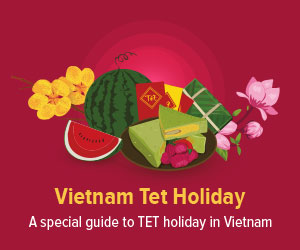The Nom - Ancient Vietnamese Script
Not only foreigners take Nôm (ancient Vietnamese script) for Hán (short of Hán Việt, ancient Vietnamese-Chinese script) but most of Vietnamese think that Hán and Nôm are one thing. Actually, like Japanese script, Nôm used to be ancient Vietnamese script, which was used widely by Vietnam ancestors. Yet, it is dying very fast.
A Hard Lot Of Nôm
Like Japan and Korea, which created their own scripts by adapting from Chinese characters, Vietnam had its own script named Nôm as well. Although dominated by Chinese feudal regime for almost a thousand year, the old Vietnamese manage to come up with their own system to record all the local words, and through time, Nôm has come to record almost every Vietnamese particular features, from language to culture, politics to economy.
 Calligraphy slowly makes it returns - Photo: @namdong__huu
Calligraphy slowly makes it returns - Photo: @namdong__huu
Though Nôm had strong vitality among people, it was not used at important function in court. It had experienced a disdained lot during thousand years of feudal regimes. One who could not use China script fluently was not considered knowledgeable while a Nôm-fluent scholar is underestimated. A long time in the past ancient Vietnamese is disregarded by their own people.
The idea that Hán Việt is superior to Nôm was deeply engraved in minds of many Vietnamese people at the time. Even when Nôm was at its golden age, it could not assume its true value.
Later on, when modern Vietnamese used Latin characters as the Vietnam national script (quốc ngữ), Hán Việt and Nôm were quickly forgotten by people. A long time after the appearance of Quốc ngữ, Vietnam people did not have any Hán Nôm class, even mentioning Hán Nôm was considered backward.
After the advent of the national reunification, the government realized the importance of preserving the heritage and started to reopen Hán Nôm classes. Unfortunately, too many things had lost and with Nôm in particular, the hard lot now comes to its peak.
A Lost Nôm And Precious Things Went With It
Coming to Văn Miếu street, Hà Nội on Tet holiday one can witness the once prime time of Nom. “You can see a colorful street and think that Hán Nôm is being restored to former prosperity. However, people like me see something else”, said Văn Hợp, a Hán Việt writer on the street.
The street is full of traditionally red color paper and people coming asking for pieces of calligraphy. However, among nearly 60 so-called calligraphers there, there is only one man giving Nôm calligraphy. The rest gives Hán Việt calligraphy.
How come things end up that way? Does the above hard lot have anything to do with the situation? Actually, there are many factors contributing to “help bring down” the precious script. One of them is the bias long existing in the past.
 Young Vietnamese are slowing making their way back to a glorious culture's past
Young Vietnamese are slowing making their way back to a glorious culture's past
Everyone knows what can be lost when a language dies. The remains now of Nôm literature are what can be called real Vietnamese language. However, few people can read Nôm, let alone their ability to write Nôm and especially, draw a piece of calligraphy.
“Many cultural traits had gone with Nôm, the features that tell us about what a pure Vietnam is, how our ancestor lived and behaved in the past, the way they cured common illness through their own characters”, said Hán Nôm Doctor Cung Khắc Lược.
According to this heading calligrapher in Việt Nam, Nôm is considered more complicated than Hán Viet, and that is one of the reason makes it so unpopular. However, Nôm contains in it numerous cultures, Vietnam economy feature in the past and reflecting the people daily life lively.
For a foreigner, she can find a pure Việt Nam though a Nôm word. However, many scholars are scary when thinking of Nôm future. For Nôm, time is running the shortest.

11 Horoscopes In The Year Of The Dragon
The dragon year can be a booster-for-all for all other zodiacs.

Vietnam's 5 Most Important Festivals & Travel Tips
Vietnam's cultural richness stands out with a variety of traditional festivals.

Kinh People
Vietnam is known for its cultural diversity with 54 ethnic groups, in which, Kinh or Viet people accounts for nearly 90% of the whole population.






